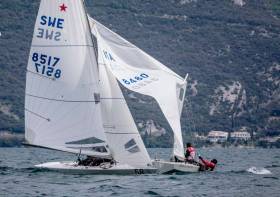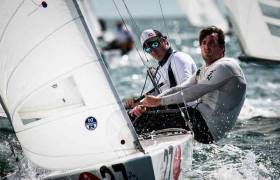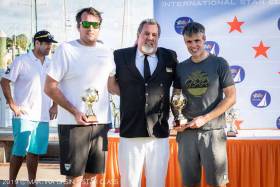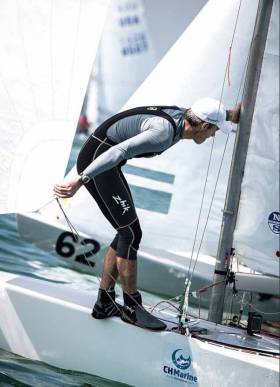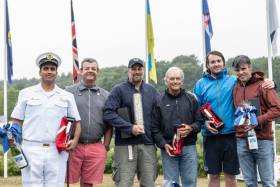Displaying items by tag: Star
Top 20 for Ireland's Star Sailors Peter & Robert O'Leary on Day Two of European Championships
Cork Harbour's Peter and Robert O'Leary - and Ireland's sole entry - are 19th from 90 at the Star Sailors League Grand Slam Breeze and European Championship.
Download full results here
Robert Scheidt and Henry Boening (BRA) delivered another masterclass on the second day of racing after a big day of racing in Riva del Garda, Italy.
There will be plenty of weary sailors after an epic three-race day in winds that hovered around the high teens. But with variable winds predicted later in the week, the race committee wisely decided to take advantage of today’s weather to provide flexibility later in the series.
It was not just the breeze that was taking its toll on the teams, however, as the 1.5 mile beats consistently saw a drag race to the right-hand side of the course, making it an effective conveyer belt towards the windward mark and a hiking contest to get there first.
After day one, where tactics had been much the same as today, the race committee added some port bias to the startline to reduce the crowds at the committee boat end. It certainly saw a spread in the field with many fighting for the pin end and several teams coming unstuck in doing so. Scheidt’s day looked as though it would get off to a bad start when a port tacker managed to make a mess of the bunch of boats queuing at the pin in Race 1, of which the five-time Olympic medalist was one.
Scheidt showed his class, however, and by the first mark had miraculously hauled his way up to seventh picking off a few extra positions to finally end up third. Consistently fast, he was always near the front and was usually able to pick off a few spots downwind, showing once again why he is considered by many to be the best downwind sailor in the world. His 3, 5, 2 scoreline across the three races sees him lead the overall results by some six points, but there were plenty of other teams looking dangerous in these testing conditions.
Diego Negri (ITA), sailing with Frithjof Kleen (GER) also had a good day picking up a 1, 10, 3. With another win on their scorecard from day one and a discard in play after four races – allowing them to drop a UFD (over the startline) in yesterday’s second race – they now sit at 2nd overall and, like Scheidt, are looking consistently strong downwind. “I think downwind I have often been quick and I think that comes from sailing a Laser all those years,” Negri explained. “It has been a while for me since I sailed a Laser, but the years sailing that boat put you in touch with the waves and that was very important today. But Frithjof was also doing a great job working the boat today.”
Another sailor showing their form was 2012 Olympic star gold medalist, Freddie Lööf (SWE), who improved throughout the day to take the win in the final race by a country mile. Lööf was one of those who struggled near the raft of boats at the pin end in race one: “The first race was difficult as the left side of the startline was really biased, so it was hard to get out of that side. Then they changed things later on and it was great for the rest of the day. It was still hard to get off the line and get over to the cliffs in space but that is the same for everyone.” Lööf’s 11, 3, 1 is particularly impressive as his crew, Brian Fatih (USA), is nursing an injury after being hit in the back by another boat yesterday.
One of yesterday’s top performers, Paul Cayard (USA), looked set to continue his form, taking a second in the first race of the day. But bad starts in the second and third races saw him struggling to break into the very top placings. His 2, 24, 10 over the course of the day is hardly a disaster and he did extremely well to mitigate the damage, but he’ll expect better results tomorrow.
If the day cannot be categorized as a disaster for Cayard then the last race of the day will certainly be labelled such by Mateusz Kusznierewicz (POL) and Frederico Melo (POR) who were looking fast all day taking a sixth in race one and victory by a big margin in race two. “For us we have been really enjoying the downwind and I think we have been going really fast,” Mateusz said at the end of the second race. But fighting for a podium position on the final run of the day the Pole’s mast snapped in two leaving him to drift towards the finish – where he still managed to pick up a 27th for his drifting efforts.
Tomorrow looks set for more of the same with a 1pm start and two races scheduled, and will be streamed live on internet with expert commentary from double Olympic gold medallist, Shirley Robertson (GBR) and Star Olympic campaigner and coach, Maurice O’Connell (IRL). On the water, the latest in hi-tech camera technology, as well as 3D tracking Graphics, will provide thrilling viewing.
1 BRA Robert Scheidt Henry Boening
2 ITA Diego Negri Frithjof Kleen
3 POL Mateusz Kusznierewicz Frederico Melo
4 USA Paul Cayard Arthur Lopes
5 SWE Fredrik Lööf Brian Fatih
6 USA Eric Doyle Payson Infelise
7 FRA Xavier Rohart Pierre-Alexis Ponsot
8 ITA Roberto Benamati Alberto Ambrosini
9 GER Ubert Merkelbach Markus Koy
10 CRO Marin Misura Tonko Barac
Cork Harbour brothers Peter and Robert O'Leary are lying 13th overall after the opening day of the first ever combined Star Sailors League Breeze Grand Slam and Star European Championships dawned with a change in conditions from the blue skies and sunshine, which had filled the skies over Rival del Garda, Italy, for the practice race.
With little-to-no breeze in the morning, the reliable Ora wind dutifully arrived somewhat earlier than usual and was already blowing hard by the time some of the legends of the fleet had concluded a formal press conference at 11am.
Check out the video and analysis from our own Prof O'Connell as he is interviewed by Star Class presenter Digby Fox below.
With the cold breeze firmly in and grey skies covering the beautiful Lake Garda, it was a hesitant fleet who headed out to the race course with many choosing a last minute coffee in the Yacht Club bar before finally getting into their sailing kit and making their way to the race area.
Once onto the racecourse, however, it was a slightly different picture. With the Ora funneling up the lake and Riva del Garda located on the very northernmost shore, the wind was slightly more moderate when the sailors reached the startline – though it still looked like it was going to be a tough day at the office with the wind holding in the high teens.
With a few minutes to go until the first start, it became obvious that the right hand side of the course was favoured by most teams, with the majority of the fleet lining up at the committee boat end of the line jostling for space. Clearly this was going to be a classic Garda race with teams vying to get away from the startline in space and be the first to tack at the cliffs on the right of the course, where the pressure was greatest and the wind funnels down the edge of the lake.
During the morning’s press conference the sailors had been asked who they thought might win the event and all had replied in the expected humble tones, praising the quality of the competition and saying it was anyone’s game. One of those hotly tipped to take the title this week, Paul Cayard (USA), had replied that he was “just happy to be here sailing a Star” and that “was winning already.”
Cayard’s start to race one, however, told a different story, one of a man entirely more determined to take victory on the water this week. He, along with crew Arthur Lopes timed their run into the committee boat end to perfection and hit the line at pace. Closest to the committee boat, they also had the space to tack off to the favoured side of the course as, and when, they chose.
Italy’s Diegro Negri sailing with Frithjof Kleen (GER), and Roberto Benamati and Alberto Ambrosini (ITA) both also had strong starts at the committee boat end and got away towards the cliffs in the leading bunch. Five-time Olympic medalist Robert Scheidt (BRA) was also in the running with this leading pack.
Garda, when the Ora is blowing, can be something of a one-way track and today was no exception. The biggest challenge for the sailors was spotting the layline for the windward mark from a long way out with many losing places by going too far and overstanding. Scheidt, long known for his downwind prowess was looking quick in these breezy conditions but the skies where starting to clear and the wind was moderating somewhat already. By the bottom mark the Brazilian had moved himself up to third and was hot on the heels of Cayard with Negri still holding on to the lead. With few passing opportunities, these three held onto their positions to the end, with Scheidt pushing on the downwind but not quite having the legs to get away from Cayard ahead.
With the afternoon wearing on, it was a short turnaround to race two but already the breeze was feeling much softer and, at the time of the second start gun at around 15:00 the wind had reduced to the early teens and the sun was finally breaking though the heavy cloud layer.
Once again it was Cayard who nailed the start getting to the committee boat again at speed and showing his America’s Cup skills.
Despite the moderating wind and the funnelling effect at the cliffs being much reduced, it was still a fight for the right-hand side of the course. Though for this race, with the windward mark moved it was a case of short tacking up the shore with a great many calls for water and shouts of ‘starboard’ echoing off the cliff walls. One of these port/starboard incidents was, unfortunately very costly with Tom Lofstedt and Anders Ekstrom, and Gugliemo Danelon and Mattia Gazzetta coming together, resulting in the loss of the latter’s rig – something more often seen on Stars going downwind in big breeze!
Once again it was a battle between Scheidt and Cayard near the front of the fleet this time with polish Star hero, Mateusz Kusznierewicz with Frederico Melo leading the charge to the first windward mark. And again Scheidt was looking quick downwind and was working hard to try and make the most of his pace on a downwind, which was almost exclusively sailed on port gybe and so limiting the tactical possibilities.
If there was to be an overriding narrative of the day’s sailing then it would be that Cayard was looking particularly strong on the upwinds and Scheidt a force to be reckoned with on the downwinds. That being the case, it was little surprise to see the American at the front of the fleet at the final windward mark of the day, but Scheidt closely followed him with another American, Eric Doyle and his crew Payson Infelise, having worked their way into the top three. “On the last downwind we all gybed early and I went left, thinking I would protect that side,” explained Cayard after the finish “But Robert [Schedit] and Eric [Doyle] found a bit more pressure than us and just sailed round the outside.” So it was, that the Brazillian picked up the second race to add to his third, with Doyle in second and Cayard in third.
“I’d say that was a pretty good day at the office,” Cayard said when ashore. “We were really happy with that start in the first race and it was great to do it again in the second too. Sometimes Garda can be a bit one-sided on days like today so you really have to fight to be where you want.
“Robert [Scheidt] is one of the greatest downwind sailors in the world but I feel like we had enough to hold him at bay today. And I’ve always been strong upwind so we were happy with our speed there. We’ll see what the rest of the week holds…”
It’s foolish to draw any conclusions at the end of the first day of racing. Certainly, Cayard and Scheidt seem the form boats from today’s racing, but with the fleet this competitive, many have picked up some big scores already. In this fleet, it only takes one off-day to drop out of the top ten overall and so miss out on the final elimination series, on Sunday, May 19th, to be crowned Star European and Sailors League Grand Slam Breeze champion.
Anthony O'Leary Seventh in Bacardi Cup Viper Class
Anthony O'Leary and his Cork Harbour crew of David Hassett and Niall Rafferty in Antix have finished seventh overall at the Bacardi Cup Invitational Regatta in Miami at the weekend in the 19-boat Viper 640 class. His sons Nicholas and Robert, sailing 'Brotherly Love' under the burgee of Baltimore Sailing Club and competing in the Star class, finished 12th overall in their 64-boat fleet.
Overall results are here.
Biscayne Bay showcased the best day of racing as this iconic racing venue said good-bye to the 500 sailors who competed. A great Easterly breeze of around 10 knots, sun shining warm and wave chop a lot less than the previous days made for a perfect race day. All of the classes finished their scheduled races at this the best spring sailing yacht racing event in the North Hemisphere.
In the Star Class, the charge for the 92nd Bacardi Cup victory came down to an American Gold Star battle. Eric Doyle/Payson Infelise (USA) presented a flawless scorecard with results always in the top 4, but Paul Cayard/Magnus Liljedahl (USA) managed a brilliant come back from a 27th in race 1 and earned a chance to steal the win from Doyle/Infelise. But only if they could maintain the momentum that gave them wins in Race 4 and 5. Both teams started on the right side, with Doyle keeping an eagle eye on Cayard who was almost on pin end and kept following that track. The Southern California partnership of Doyle/Infelise were first to the windward mark, whilst in a surprise turn of form North California legend Paul Cayard rounded at the back, in about 20th position.
The order of play continued at the downwind gate and up the second windward leg. At this point, Doyle/Infelise realized they were safely ensconced as winners of the 92nd Bacardi Cup and could abandon the race and head ashore! Even though Paul Cayard/Magnus Liljedal were slowly climbing back through the fleet, there was no hope of them overhauling Doyle/Infelise’s points advantage. Then, on the second downwind, they broke their mast and were forced to be towed back in. Scoring a DNF penalty, they had to re-count their 27th from day 1 and plummeted down the leaderboard to finish in 7th overall.
Standing alongside Doyle/Infelise on the podium were Mateusz Kusznierewicz (POL) and Firithjof Kleen (GER), who also gave themselves an uphill start after a UFD in race 1, but won two races from the remaining five and finished only 2 points behind the winners. Another two points back were bronze medalists Eivind Melleby (NOR) and Joshua Revkin (USA). In fourth were defending champions Diego Negri and Sergio Lambertenghi of Italy and in fifth the French Xavier Rohart and Pierre-Alexis Ponsot.
“It’s been great, fun, fabulous weather, it all came together nicely, we had great speed, a fantastic team work, good starts and it’s great to be in this excellent field with incredible champions,” smiled a very satisfied Eric Doyle. “It is our first win even though I have sailed here for 20 times. One time we had a big fight then Ross McDonald came ahead I lost my points; it doesn’t matter now, it’s great we won it! And we are happy to win 2500 points of the Star Sailors League. We plan to go to the Europeans/SSL Breeze Grand Slam in May and then to the Worlds in Porto Cervo in June, so plenty of racing coming ahead!”
On the race courses closer to shore, action was unfolding for the J/70, Melges 24, Viper 640 and the Flying Tigers 7.5 who contested their last two races of the series.
In the J/70, the winners were the team on Catapult (USA), featuring Joel Ronning, Victor Diaz del Leon, Patrick Wilson and Chris Stoke. They were the most solid and consistent of the fleet with every score inside the top 3, after discarding their 11th in race 3. They racked up a 16 point advantage over second placed Americans onboard Surge with Mark Mendelblatt calling tactics, and in third was Italy’s Calvi Network with Carlo Alberini driving.
“This was a very fun team to sail with we all got along very well,” commented Joel Ronning of Catapult. “This group of people are very good at what they do. We had tremendous fun, we were able to minimize mistakes by keeping the dialogue open and if there were any issues they were taken care of right away. It’s a phenomenal event and one of the premier series in the world. It’s very well organized. We love Shake A Leg, we love Bacardi, everybody is so welcoming and we will definitely be coming back.”
A big fight in the Melges 24, where, despite domination from a 19 boat American team line-up, it was the Italians on Italian Bombarda who claimed the win. Their super crew was all home-made in Italy: Andrea Pozzi, Carlo Zermin, Matteo Ivaldi, Nicholas Dal Ferro and Stefano Ciampalini. Full Throttle (USA) with Olympic tactician Jonathan McKee finished in second and Monsoon (USA) in third, with just 1 point between each of the top three teams.
“We loved the conditions here,” said Andrea Pozzi of Bombarda. “It’s the ones we love and perform better with. The crew has been working together for a long time, even though we are coming back together after a year’s break. Miami is a fantastic spot, we love it and we loved the event. It combined the sport of sailing to the fun in the after sail, we want to thank Bacardi for this!”
Evil Hiss stepped up today to win the super competitive Viper 640 class: Mary and Geoff Ewenson with Star Olympian Tyler Bjorn won the last three races of the series leaving no doubts as to who was the best in the fleet. Great Scott!slang (USA) came in 6 points behind in second place, and first Corinthian team, and Choppy Seas (USA) completed the podium in third.
“We got better as the days progressed. Choreography on the boat was just perfect,” said Geoff Ewenson. “The crew was very experienced and we were able to make good decisions. I’ve sailed in Miami enough so that it almost feels like sailing in my home waters. I remember coming down to Miami to sail the Bacardi Cup in Stars and now, the last three times as part of the Bacardi Invitational in Vipers. Love the organization, love Biscayne Bay and I can’t wait to come back next year.”
The best of the Flying Tigers 7.5 was Neun (CAN) with Geoff Becker, Richard Griffin, Sabine Griffin, Joe Mele and Adam Spiegel onboard. Finishing in style, they won the last race of the series. Just one point behind, Grassy Manatee (CAN) finished in second, with J.A.C.K.ed (USA) is third.
“We just had awesome team work,” explained Geoff Backer of Neun about their win. “Beautiful clear conditions, warm water, warm air, everything was fantastic. We had such great fun and we’ll definitely come back next year!”
As the curtains prepare to drop on the Bacardi Cup Invitational Regatta, tonight it is all about the big Prize Giving Ceremony and dinner party at Shake-A-Leg Miami to officially close the 2019 edition. Bacardi is already planning the 2020 edition with the 93rd Bacardi Cup for the Star class, the event that launched this all in 1927 in Havana, Cuba.
Cork's O'Leary Brothers Eye Top Ten at Bacardi Cup
Cork Harbour pair Nicholas and Robert O'Leary have moved up to 11th overall after the second raced sailed of the 2019 Bacardi Cup Invitational Regatta in Miami yesterday.
The new Baltimore Sailing Club combination are the only Irish crew competing in the Star class in Florida but as Afloat.ie previously reported their father Anthony will be racing in the Viper class at the same venue starting today.
Results are here
As the fleet departed from the Coral Reef Yacht Club, day three of the 92nd Bacardi Cup delivered a brisk northerly breeze day under a clear blue sky and bright light.
A 15/18 knot breeze from the north-east, with very choppy seas gave an exhilarating if challenging ride for the 64 teams, with one bent mast the only recorded damage. The Committee hoisted the AP flag to wait for the wind to settle and a little after midday the starting sequence began with U flag up for security reasons.
After a rough upwind leg, Norway’s World Champion Eivind Melleby with his American crew Josh Revkin were the first to round the mark, followed by Eric Doyle/Payson Infelise (USA), both chased hard by Paul Cayard/Magnus Liljedahl (USA). The iconic partnership of Cayard/Liljedahl knocked out a fantastic and fast paced downwind leg, accelerating to be first at the gate, leaving Melleby/Revin second and Olympic Champion Mateusz Kusznierewicz (POL) and Frithjof Kleen (GER) still pushing hard in third.
Making their break, the newly formed Kusznierewicz/Kleen team opted for the right side of the upwind leg and eased into the lead, extending their margin further on the second downwind leg, with Eric Doyle/Payson Infelise now in second, and Cayard/Liljedahl third. Moving into the fifth and last leg, Kusznierewicz/Kleen controlled their lead, whilst behind Cayard/Liljedahl advanced to second, passing Doyle/Infelise who had to be satisfied with a 4th place finish. But their consistent two-race scorecard of 3,4 rewarded Doyle/Infelise at the top of the leaderboard and the team to now oust.
“It would have been nicer to keep the lead and win a bullet for Magnus’ birthday,” grinned Paul Cayard. “But it was very shifty out there and we had to battle with some very good sailors. Second is good, we are pleased with the result and look forward to tomorrow.”
“Winning always feels nice,” reflected Mateusz Kusznierewicz after their dominance. “We missed Race 1 yesterday for being UFD, so today was our first day racing together and it was fun. I liked sailing with Frithjof and in these great conditions.”
Tomorrow PRO Carl Schellbach will aim for two races for the Star fleet by starting an hour earlier at 11:00. Embarking on their first race day on Biscayne Bay will be the other classes invited to the Bacardi Invitational Regatta, as the J/70 fleet appears here for its second consecutive year, the Melges 24 returns after a short break and the Viper 640 and Flying Tigers 7.5 fleet make their debut at this the best sailing week in Miami.
Plenty of talent in the J/70 including defending title holder Joel Ronning (USA) on Catapult, and his rival Brian Keane (USA) on Savasana. Also eyeing the podium will be 2018 J/70 Worlds gold medal winning crew Lucas Calabrese, who features on the starting line in Miami as a key component of the team on the USA’s Mr Pitiful, skippered by Kevin Downey. Calabrese was also part of the silver medal J/70 team at last year’s Bacardi Cup Invitational Regatta, so brings plenty of experience to the race track. Add to that Calabrese’s bronze medal in the 470 at the 2012 Olympic Games, eleven years after being crowned Optimist World Champion, and you have a player who knows how to succeed under pressure.
The 2018 Worlds bronze medallists are the class act to watch in the Melges 24 fleet. Under the super-competent eyes of Bruce Ayres, they are brimming with confidence fresh from wrapping up their second consecutive Melges 24 Winter Series win in Miami at the start of this year.
Whilst Canadian teams dominate the Flying Tiger 7.5 entry list, with 6 teams from Oakville taking to the race track, the leaderboard is wide open as to who will secure victory. Over in the 19-boat Viper 640 fleet competition is also hard to forecast, but eyes for sure will be on Brad Boston (CAN) and his team on Jackpot who wrapped up victory at last year’s North Americans, and also well up in the mix will be Mary Ewenson who finished third.
An 11:00 start is scheduled for all fleets tomorrow on Biscayne Bay. The Star fleet is targeting races 3 and 4 of the Bacardi Cup, while J/70, Melges24, Viper 640 and Flying Tigers 7.5 will face their first three races of the series. The weather forecast should see a return to classic Miami conditions, embracing the usual warm temperatures and steady mid-range breeze.
Cork's O'Leary Brothers 13th After Race One of Bacardi Cup
Nicholas and Robert O'Leary were 13th in race one of the 2019 Bacardi Cup Invitational Regatta in Miami yesterday. It was a new departure for the O'Leary campaign with 2020 Vendee Globe hopeful Nicholas taking the place of Peter on the tiller of the family's Star keelboat IRL 8527, named 'Brotherly Love'.
The new Baltimore Sailing Club combination is the only Irish crew competing in the Star class in Florida but as Afloat.ie previously reported their father Anthony is racing in the Viper class this week at the same venue.
Results after day one are here
A sunny and very hot South of Florida morning welcomed the 128 Star sailors at Coral Reef Yacht Club for the first day of the 92nd Bacardi Cup.
The regatta is one of the most appreciated competitions in the sailing calendar, with a long and celebrated history starting in Havana, Cuba in 1927. Since then, with only ten boats in the line-up, the Bacardi Cup has grown into one of the world’s major sailing events with peak records of more than 100 entries. In 2018, the Bacardi Cup Organizing Committee extended an invitation beyond the Star Class, to embrace other high-profile one-design fleets, making the Bacardi Cup Invitational Regatta one of the most attended spring sailing events. The J/70, Melges 24, Viper 640 and Flying Tiger 7.5 will begin their racing on Thursday, March 7th, but today it was all about the Star Class.
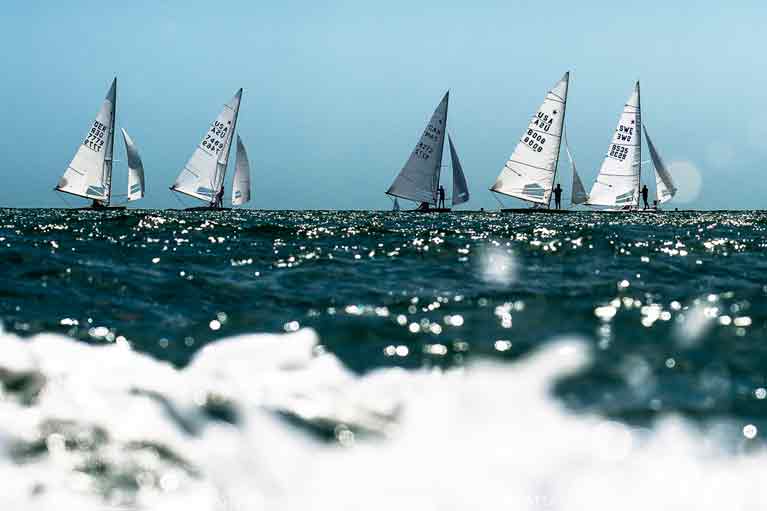 Stars go downwind in Miami Photo: Martina Orsini
Stars go downwind in Miami Photo: Martina Orsini
After the skippers briefing, the 64 teams headed to the Biscayne Bay race course for a 11:55 hours start. No surprise the fleet was eager to get going, with PRO Carl Shellbach giving two general recalls before Race 1 got underway. The black flag played its deterrent role and only three boats were over the line, among them Polish Olympic Gold and Star World Champion Mateusz Kusznierewicz, racing with World Champion crew Firthjof Kleen.
The upwind leg opened with a light breeze of 6/7 knots from ashore, with most of the fleet opting for what they predicted was the favourable left side. First to the windward mark was Italy’s Diego Negri with crew Sergio Lambertenghi, winner of the 2018 Bacardi Cup, followed by the Norwegian World Champion Eivind Melleby with Josh Revkin (USA). The two exchanged positions in a tussle to the downwind gate, before Negri/Lambertenghi stepped up their pace to reclaim the advantage in a tricky second upwind leg. Behind, Augie Diaz and Bruno Prada came through, in a masterclass of ‘right place at the right time’ as the wind began its big shift to the right. A few boat lengths into the last leg saw the morning wind drop, giving way to a different breeze from the land to give the race an unexpected reaching finish.
Letting the fleet know they have every intention of defending their 2018 title, Negri and Lambertenghi kept their lead in front of Augie Diaz/Bruno Prada, with Eric Doyle/Payson Infelise finishing in third. After starting strong, Eivind Melleby/Joshua Revkin could only hold onto an eighth place.
“It is such a great feeling to be leading this excellent fleet,” smiled Diego Negri after racing. “The day was really tricky with two pressures fighting each other, so the first half of the race the left side was favourite while on the second half it was the right that ended with a reaching finish. We kept eyes well open, we kept control and we managed to finish with a bullet in a first beautiful race.”
Tonight, teams are guests of Eddie Cutillas at the beautiful Bacardi Building for the traditional welcome cocktail, where the BACARDÍ rum team will greet and host the competitors. BACARDÍ has sponsored the event since its inception in 1927. The nightly parties make sure the fun continues long after the finish line. Next social event will be the Mid-Week Party at Shake-a-Leg Miami on March 6th to mark the half-way stage of the event and the Prize Giving Dinner on Saturday, March 9th.
Before that, tomorrow another sailing day awaits the 64 teams for Race 2 of the 92nd Bacardi Cup, with an 11:55 starting sequence and more head to head battles set to unfold.
Royal Cork's O'Leary Brothers Continue Medal Haul in Miami
Royal Cork and Baltimore Sailing Club's O'Leary brothers are making most of their trip stateside and chalked up third overall yesterday in the Miami-based Star Winter Series. They won the Walker Cup sailed as part of the series at the weekend, beating America's Cup legend Paul Cayard in the process.
Peter O'Leary and his brother Robert add this result to the bronze medals won last week at the inaugural under-30s championships at the same venue.
Official results here.
Cayard is the overall winner of the Star Winter Series that consists of five events held at Coral Reef Yacht Club from November to February.
Races 7 & 8 of the Star Midwinter regatta were held today in perfect Star Sailing conditions of 12-14 knots from the southeast. Warm air, warmer water, nice waves for surfing downwind and plenty of sunshine.
Cayard finished strong and moved up to second place with 60 points in this regatta. By virtue of moving up today, he won the Star Winter Series. The Star Winter Series is the cumulative score of 5 events starting in November and concluding in February. Cayard had two crews sailing with him over four of the five events; Magnus Liljedahl and Josh Revkin.
Eric Doyle won both races today and moved up to third place with 62 points passing Augie Diaz and Bruno Prada.
The racing was very tight and the lead changed hands several times in all races. Eric Doyle rounded the last mark of the final race in 5th and managed to grab the win.
The event also featured longtime Irish ex–pat Star sailor Mark Dolan.
Final Top Ten
1. Paul Cayard / Magnus Liljedahl, USA, 27
2. Eric Doyle / Payson Infelise, USA, 27.4
3. Peter O'Leary / Robert O'Leary, IRL, 45
4. Tomas Hornos / Pedro Trouche, USA, 56
5. Augie Diaz / Bruno Prada, USA, 58
6. Jake Lilley / Lewis Brake, AUS, 90
7. Ante Razmilovic / Brian Hammersley, GBR, 91
8. Jørgen Schönherr / Jan Eli Gravad, DEN, 91
9. Arthur Anosov / Mark Dolan, USA, 91
10. Jennings / Jon Von Schwarz, USA, 93
Royal Cork O'Leary Brothers Take Bronze Medals at Star Junior Worlds
Royal Cork Yacht Club and Baltimore Sailing Club's Robert and Peter O'Leary were bronze medalists at the first Star Junior World Champion Under 30 after a six-race regatta in the water of Biscayne Bay in Miami, Florida yesterday.
“It’s been great racing this week, I was at the helm but my brother still did most of the tactics – said Robert O’Leary – and we are already looking forward to the next event in Riva del Garda next year in October, it shall be good. This was the first Junior World Championship and it’s been so successful with 36 competitive boats, it’s good to see all these young guys in the class.”
American sailor Luke Lawrence is, with crew Alexey Selivanov, the first Star Junior World Champion hosted by the Coral Reef Yacht Club and organized by the International Star Class.
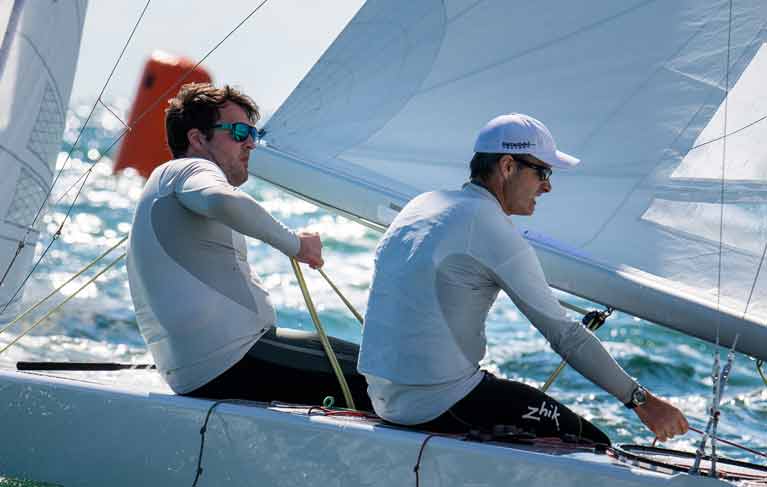 Robert (left) and Peter O'Leary on their way to third overall at the Star Junior Worlds in Miami. The sole Irish team had support from Cork based marine firms CH Marine and sails by North Sails Ireland from Crosshaven Photo: Martina Orsini
Robert (left) and Peter O'Leary on their way to third overall at the Star Junior Worlds in Miami. The sole Irish team had support from Cork based marine firms CH Marine and sails by North Sails Ireland from Crosshaven Photo: Martina Orsini
The championship started off well for the team who won the inaugural race of the series on Monday, then handed the lead last night to Charlie Buckingham and Austin Sperry (USA) and even today, on the last downwind they were second to Tomas Hornos (USA) and Pedro Trouche (BRA). But the finish line was upwind and they managed to pass a couple of boats, all they needed to conquer the first ever Star Junior World Championship title.
"I was at the helm but my brother still did most of the tactics"
“We had a great time, we worked very well together and we had much fun – said an enthusiastic Luke Lawrence – We have to thank doctor Jim Revkin without whom this would not have happened if he hadn’t called me five days before the event and told me Alexey was ready to crew for me and gave us the boat 8507 and new sails. He went straight to the point of this event, he helped the new guys enter the class and keep them going. There are a lot of Star sailors who gave their boats and helped this event become possible, we have 36 boats here! I am now planning to stay in the class and race more, maybe attend the SSL Finals and I will train for that!”
Luke Lawrence is 28 years old and has been sailing for most of his life, first the Laser then his real passion the Finn, and in the past few years he fell for the Star attending the main events such as the Worlds and the SSL Finals in 2014. A little break from sailing in the past year or so, before the great comeback winning the first Star Junior World Championship in the familiar waters of Biscayne Bay.
The day started early with a 10:30am warning sequence and a very technical race with about 10 knots from East, some big shifts and a change of leaders. The young Italian Laser Radial Youth World Champion Guido Gallinaro with German Olympian crew Frithjof Kleen won the first race over the 35 teams racing.
Before the start of the last race the top teams were all within a few points and you could feel the tension on the race course that caused a general recall. This was a five leg race with the finish line set upwind, not an irrelevant detail because at the last downwind gate American Tomas Hornos with Brazilian crew and winner of the last SSL Finals Pedro Trouche were leading the overall ranking. Hornos and Trouche finished the race second behind the Irish brothers Robert and Peter O’Leary, but Lawrence and Selivanov managed to overtake enough boats on the last upwind leg to win the event by three points.
“Tricky conditions with a lot of back and forth – said Tomas Hornos with Pedro Trouche – but we are very happy with the results, it’s always good to be on the podium. We will be now busy with the Walker Cup and Midwinters starting tomorrow, it’s a long week for us. We don’t know yet what is coming after this, maybe Europeans/SSL Grand Slam maybe the Worlds in Porto Cervo, surely we’ll continue sailing the Star together.”
For most of the fleet is now time to move to the next event starting tomorrow here at the Coral Reef Yacht Club; the Walker Cup on Thursday and Friday followed by the 2019 Midwinters on Saturday and Sunday. While the next Silver Star is set for May 11th to the 19th at the Europeans in Riva del Garda, first time organized together with the Star Sailors League for what it will also be the SSL Breeze Grand Slam. At the end of the month of May the Western Hemisphere in San Diego, California, and in June the Star World Championship 2019 in Porto Cervo, Italy.
The curtains are closing on the inaugural Star Junior World Championship, with huge support by the International Star Class particularly by Executive Director Jon VanderMolen, the Star Legacy Foundation officer Larry Whipple and the Secretary of District 20 Austin Sperry.
This was the first event of a series of great ones to come over the years.
Top ten teams:
1 - USA Luke Lawrence – Alexey Selivanov
2 - USA Tomas Hornos – Pedro Trouche
3 - IRL Robert O’Leary – Peter O’Leary
4 - USA Charlie Buckingham – Austin Sperry
5 - BRA Nick Pellicano Grael – Samuel Gonçalves
6 - GBR Lorenzo Brando Chiavarini – Brian Fatih
7 - ITA Guido Gallinaro – Frithjof Kleen
8 - AUS Jake Lilley – Lewis Brake
9 - MEX Juan Ignacio Perez – Mark Strube
10 - ARG Facundo Olezza – Frederico Melo
O'Leary Brothers Now Sixth at Star World Juniors in Miami
Royal Cork Yacht Club brothers Robert and Peter O'Leary have dropped three places overall at the inaugural Star Junior World Championship hosted by the Coral Reef Yacht Club. The Cork Harbour duo lie sixth overall in a fleet of 36 after four races sailed.
It was a typical Biscayne Bay kind of day; sunshine and breeze going from 6-7 knots in the morning up to 10-12 in the afternoon. Three races were sailed as scheduled, thanks to a great job by the Race Committee with PRO Carl Schellbach, and the 36 teams, with their ’30 and under’ skippers who really enjoyed the second day of the event.
With today’s three races completed the Championship is back on schedule with the provisional leaders, after four races, American Charlie Buckingham – who moved to the Star after finishing fourth in the Laser at the recent World Cup Series event – and Star US Olympian, Austin Sperry. The American team posted a bullet in today’s last race, while the other two race wins went to Star Sailors League Finals 2018 winner Pedro Trouche (BRA) crewing for American Tomas Hornos, sitting in second place overall, and to 2017 Star World Champion crew Joshua Revkin (USA), at the helm, with Arthur Anosov as crew. Third overall are Americans Luke Lawrence with Alexey Selvanov, winners of yesterday’s only race.
“The breeze was better today – said Charlie Buckingham (USA) – our speed was good both up and downwind and we managed to be consistent. I’d love to race the Star more often, I tried to do that when I am not training or racing the Laser, any regatta that I can do, I do it. Now we’re focused on being consistent and fast again tomorrow for the last two races.”
“It’s nice to be the provisional leaders – said Austin Sperry (USA), not here as just a crew but one of the organizers behind the event, being Secretary of the District – but the best is coming back ashore and seeing the Aussie guy Jake Lilley with a big smile saying he’s going to get himself a Star and he’s going to stay here and sail at the Mid-Winters this weekend. To me that’s the win!”
The day kicked off with a clean start at 11:20 with the wind blowing from East at about 7 knots. Hornos and Trouche were leading at the first windward mark through to the finish. A bit trickier was the start of race 3 – the second for today – it took three general recalls before the Race Committee was able to see the fleet advance on the first of four legs. Revkin and Antonov were able to get a good start and control their lead over the Mexican skipper Juan Ignacio Perez and his crew Mark Strube until the end. At the start of race four, the wind had picked up to 12 knots and the seas a bit choppy and American Olympic Laser sailor Charlie Buckingham with experienced crew Austin Sperry were able to be quite fast both upwind and downwind getting the victory over Australian newbie to the Star Jake Lilley and Lewis Brake, fifth overall.
“We caught a shift right after the start – said Tomas Hornos (USA), winner of race 2 – our speed was really good, we just played out in front and we covered the fleet after that making it look easy, but it wasn’t easy. We are really happy, we needed that!”
“It took me a little while to get back into things, but it feels good – said Joshua Revkin (USA), winner of race 3, normally crewing for Eivind Melleby (NOR) – our speed is up to pace, I had a bad start in the second race and it took a lot of effort to get back into it, but the third race we got off the line and cruised to a pretty easy first place. We had a great time, it’s the perfect conditions you can have in Miami and hopefully tomorrow there’s more of the same.”
And the conditions tomorrow look to be the same as today with the first start confirmed at 12 pm, two races scheduled with no warning sequence starting after 2 pm.
The first Star Junior World Champions will be crowned tomorrow after racing with the prize giving ceremony held at the beautiful Coral Reef Yacht Club.
Top ten teams in the provisional ranking after four races:
1 - USA Charlie Buckingham – Austin Sperry
2 - USA Tomas Hornos – Pedro Trouche
3 - USA Luke Lawrence – Alexey Selivanov
4 - MEX Juan Ignacio Perez – Mark Strube
5 - AUS Jake Lilley – Lewis Brake
6 - IRL Robert O’Leary – Peter O’Leary
7 - BRA Nick Pellicano Grael – Samuel Gonçalves
8 - ARG Facundo Olezza – Frederico Melo
9 - GBR Lorenzo Brando Chiavarini – Brian Fatih
10 - ARG Leandro Altolaguirre – Lucas Altolaguirre
Full results here.
American Augie Diaz and Brazilian Bruno Prada are the winner of the Robbe & Berking Star European Championships 2018, tied to Lars Grael with Samuel Gonçalves (BRA) who are second. The Bronze medal goes to Cork brothers Peter and Robert O’Leary from Baltimore Sailing Club.
Six of the seven races were sailed even though two of the four days of racing have been quite rough with very strong stormy winds. The PRO Claus Otto was excellent in deciding the right time to give the starts, postponing on Thursday and anticipating yesterday.
The winners of today’s races were two German team, the first bullet went to Star Class President Hubert Merkelbach with Marcus Koy, and the second one to Olympic Star skipper Robert Stanjek with crew Leif Bähr. But nothing could stop Augie Diaz and Bruno Prada, not even the early start they had in race 5, that cost them to go back and re-start. Not even one mistake by the runners-up was made, Lars Grael and Samuel Goncalves, who discard a seven and are tie to the winners. A Championship well played by the Irish brothers O’Leary, who proved to be excellent team on tough conditions, winning yesterday’s race with winds gusting up to over 30 knots.
Augie Diaz: “We had really some tough days of racing, we are happy we were eventually able to recover after the first early start.”
Bruno Prada: “The regatta was decided on the last downwind of the last race, we had to be fifth to win the race tied with Lars, and we just managed to finish one boat length ahead of Eivind Melleby who was sixth. So we are super happy and lucky for the last puff.”
Best junior team were the German Dominik and Simon Fallais
Best senior team in the Ü65 ranking were the Hungarians Tibor Tenke and Miklos. Bezereti.
Hubert Merklebach, ISCYRA President: “It was really a Championship for the tough sailors, the only non stormy day was today with 15-16 knots of nice breeze. Flensburger Segel Club did a fantastic job to manage the event, they’re used to have international regattas, and proved it this week. Everything went well with a great program, even on the social side with dinner in the old Silver factory of the main sponsor, Robbe&Berking, amazing Championship”.
The Star sailors are not done for the summer with the Silver regattas, next week the North American will take place in Los Angeles, with probably very different conditions.
For full results here
Baltimore Sailing Club brothers Peter and Robert O'Leary are off to a great start at the 2018 Star Europeans Championship that officially started on Wednesday evening with the Opening Ceremony at Flensburger Segel-Club, Germany but it was yesterday that the battle on the water had its first go today.
Peter O'Leary, who is a veteran skipper of the Beijing and London Games in the former Olympic class, purchased a new Star boat late last year and has been campaigning it on both sides of the Atlantic. He previously finished as high as fourth at the Star Worlds in France sailing with David Burrows in 2011. The brothers are currently placed fifth.
Conditions on the first day of sailing in the Euros were just right, with wind ranging between 8 and 12 knots, only a little shiftier than expected. With an unusual sun and clouds mix for this summer day, the 71 boats started together on one big start line. The unsettled wind direction made it difficult to decide the favorite side, and there were lots of positions’ changes in both races.
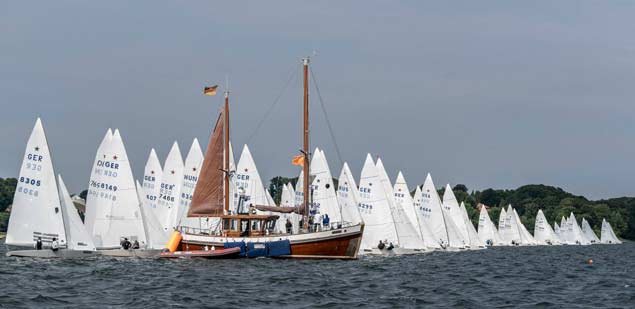 The Star European Championships start line in Flensberg. Photo: Sven Jurgensen/FSC
The Star European Championships start line in Flensberg. Photo: Sven Jurgensen/FSC
The first one was won by American skipper Augie Diaz with Brazilian crew Bruno Prada, followed by Russian Georgy Shadyuko and Aleksei Borisov, and Swiss Jean-Pascal Chatagny and Serge Pulfer. The second one went to Norwegian Star World Champion Eivind Melleby with Brazilian crew Guilherme de Almeida, second spot to Swedish Erik Dahalen and David Nogén and third to another Swiss team, Urs Hunkeler with Alex Gouda.
At the end of the first day former World Champions Augie Diaz (USA) and Bruno Prada (BRA) are the provisional leaders, followed by Lars Grael and Samuel Gonçalves (BRA) and third is the German team skippered by Ulrich Vater with crew Karsten Morf. Roberto Benamati from Italy is fourth.
From today to Sunday the 142 sailors will sail five more races under the strict command of Flensburger Segel-Club PRO, Claus Otto Hansen, who, alongside his Race Committee, decided that tomorrow’s first start will be at 14,30 local time (GMT+1), as some really strong winds are expected to hit the bay in the morning.
For full results here




























